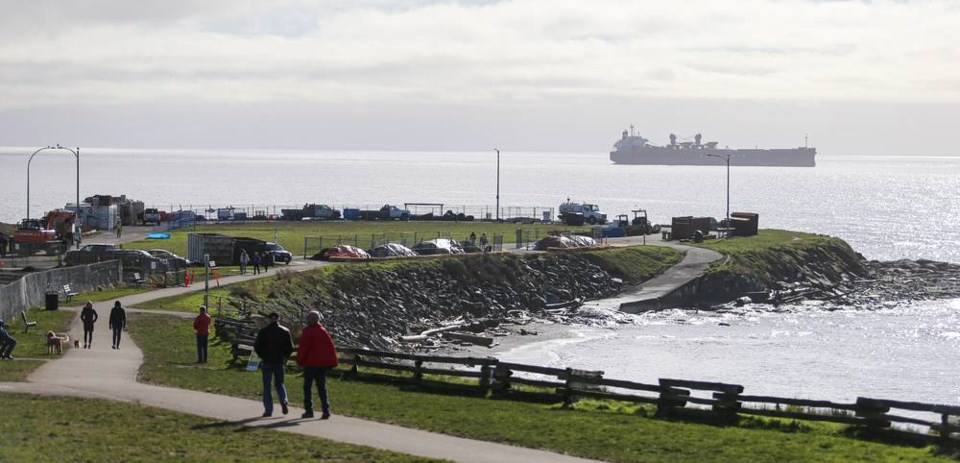Victoria city councillors have approved a partial closing of the paved loop at Clover Point Park that will increase the amount of pedestrian-only space, while still allowing some vehicle access to the waterfront.
City staff had initially recommended a full closing of the loop to create a car-free zone with lounge chairs, picnic tables, food trucks and painted asphalt.
But while many people applauded that proposal, other residents flooded council with emails criticizing the plan for its lack of accessible parking and the fact that people would no longer be able to park at the waterfront to watch storms or enjoy the view.
The approved option strikes a compromise by closing off the west side of the loop, while leaving the east side open to cars, with parking spots and a place for vehicles to turn around.
Staff say the configuration will allow for a total of 25 parking spaces — resulting in a net loss of about 65 spaces in the park. Eight regular stalls and six accessible spaces would be at the water’s edge, with a split-rail fence separating the parking area from the new pedestrian-only zone.
The change, which will cost up to $275,000, will add 2,400 square metres of pedestrian space, as opposed to 3,600 square metres with a full vehicle closure.
Council and staff stressed that the partial closing is an interim measure and that the public will have a chance to influence the park’s permanent design during a future planning process.
Mayor Lisa Helps told a committee of the whole meeting Thursday that she would have preferred a full closing of the loop, since that would offer “the best level of amenity to the widest number of people.”
But, like other councillors, she backed the partial shutdown, saying it balanced the needs of parents who want a safe place for their kids to play with the needs of people with mobility challenges who still want to visit the waterfront by car.
“Part of being the local government is that we need to listen to the local residents and I have heard — and I think we’ve all heard — a great deal of feedback about what this place means to so many people,” she said.
Coun. Geoff Young said he would have preferred a different design, but agreed that change is needed.
“I think the way it is now is disgracefully biased towards motor vehicles and against non-motor-vehicle users.”
He won support for a minor amendment that eliminates any pavement painting except as needed to delineate walking paths and bike paths. Young said the amendment was one way to save money and signal to the public that changes to the park are temporary.
Charlayne Thornton-Joe was alone in opposing the partial closing for motor vehicles, and tried unsuccessfully to amend the proposed design by shifting the vehicle turnaround further to the south to allow people in cars to have more west-facing views.
She did win approval for a motion arguing that the city’s orca sculptures should be installed downtown as originally intended, rather than at Clover Point.
Coun. Stephen Andrew initially proposed leaving the park as it is, and closing it to automobiles every other week until a more permanent plan is developed.
But his suggestion didn’t gain any traction with the rest of council and Andrew eventually voted in support of the partial closure, which passed 8-1.
Joanne Neubauer, president of the Action Committee of People with Disabilities, expressed disappointment with the decision. She spoke out against the initial proposal and said she received emails of support from people who, like her, want the loop left as it is.
“I mean if you’re going to have parking it probably should be on the west side more than the east side, because usually people go down there to watch the sunset,” she said. “Lisa [Helps] keeps talking about change is hard for everybody. It’s not that. It’s the change is not the right change, and that becomes the problem.”
Don Monsour, president of the Fairfield Gonzales Community Association, said he received more feedback on the Clover Point issue than any other in his eight years with the organization. People were frustrated by the seemingly rushed nature of the decision and, of about 1,000 residents who contacted the association, half wanted the loop left as is, while the other half were in favour of change, he said.
In that sense, the partial closure is better than the full closure proposed by city staff, said Monsour, who thanked the city for coming up with additional options.
“Let’s see how it plays out in the future for its accessibility and its acceptance to everyone,” he said. “We’re looking at this as a model, not as a permanent solution.”



